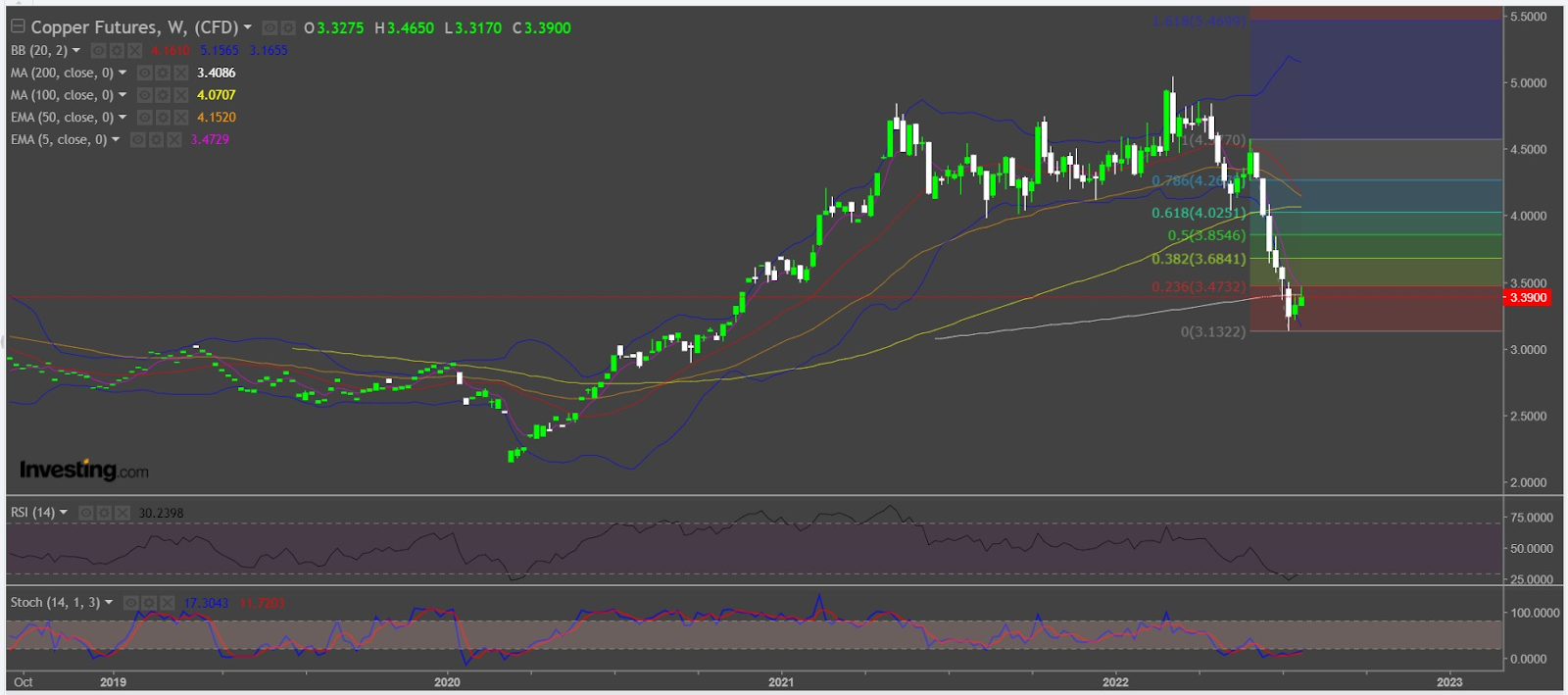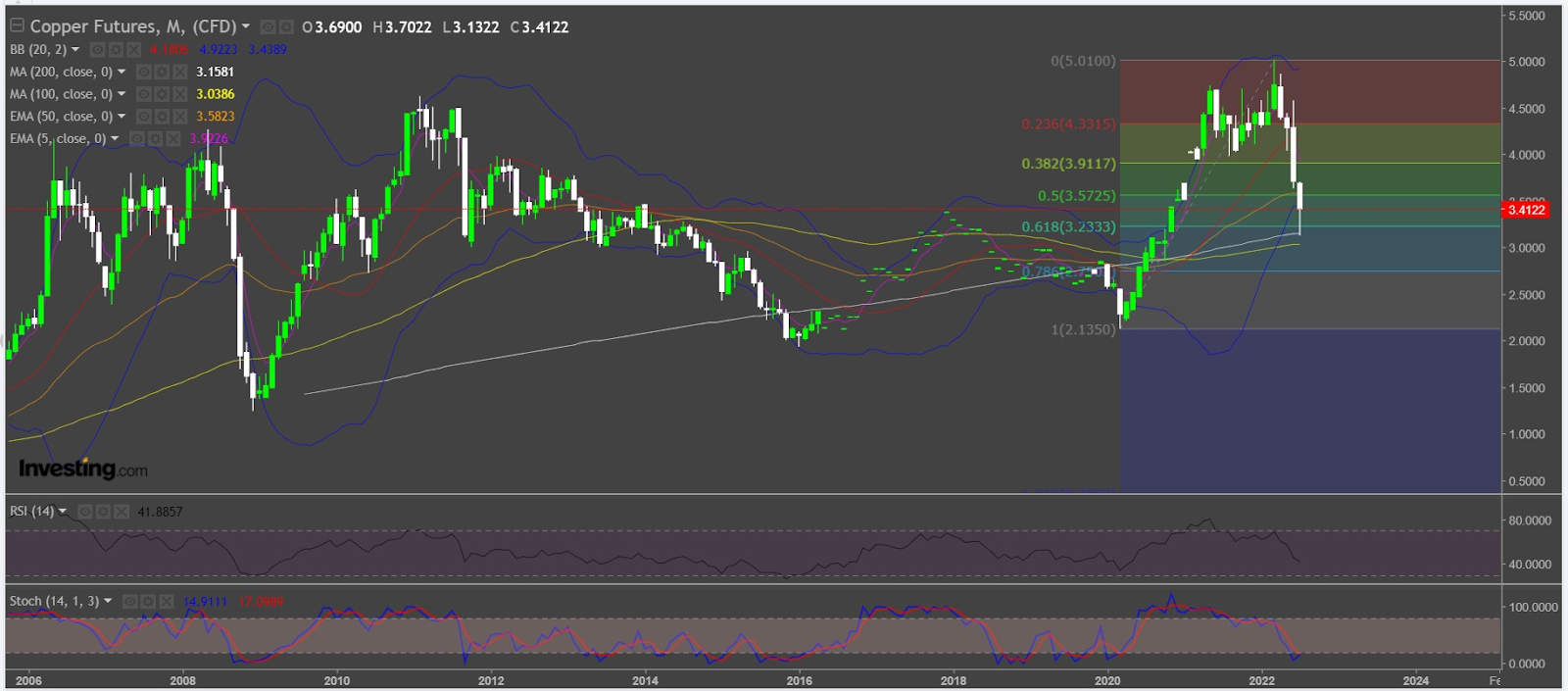- Copper’s longer-term outlook far superior to its near-term
- Down 24% on the year, and 33% below March record highs
- Metal oversold and having one of its worst years
US copper producer Freeport-McMoRan (NYSE:FCX) said last week that while it was positive about the metal’s long-term outlook, it was also realistic about its near-term direction. It cited runaway inflation, soaring interest rates, and a pricier dollar that have combined to create the headwinds seen now in copper prices.
Freeport couldn’t have been more lucid on what it thought about the world’s most 'intelligent' commodity. Critical to the power, telecom, construction, and multiple other industry sectors, copper’s read on the economy is so fabled that it’s even called ‘Dr. Copper’. It’s said that sometimes an analyst can grasp the health of the world economy and predict its turning points just by studying how well copper prices are doing.
It is perhaps not surprising then that copper is having one of its worst years ever as markets are saturated with talk of an oncoming recession.

Charts by skcharting.com, with data powered by Investing.com
Copper’s most-active contract in New York-traded COMEX futures hovered at just above $3.38 per lb in Wednesday’s pre-US trade—about 24% lower from the December 2021 close of $4.44. Even more, it has fallen almost 33% from this year’s record high of $5.01 seen in early March, during the height of the global convulsion in commodity supplies caused by Russia’s invasion of Ukraine.
Copper’s charts signal that COMEX futures for the metal are oversold, and a forceful rebound could come in days. Yet, worries that the global economy will tank are holding back that recovery. Don’t fault copper for what it’s doing. it’s behaving exactly as it should—via its investor, of course. It’s the economic signals that should be faulted—because there’s a great debate going on now about whether the US is even headed for a recession and if it is, how long or short it will be.
There’s good reason for the uncertainty.
Recession Or No?
Essentially the debate on the economy is down to two camps: the for-recession camp, led by economists like Nouriel Roubini and former Treasury Secretary Larry Summers, and the no-recession camp featuring Treasury Secretary Janet Yellen, along with Federal Reserve bankers and White House advisers.
Roubini says there are “many reasons why we are going to have a severe recession and a severe debt and financial crisis”. The economist, dubbed 'Dr. Doom' by Wall Street, adds:
“The idea that this is going to be short and shallow is totally delusional.”
Summers says “there is a very high likelihood of recession” this year and that “we've been in this kind of situation before … [and] a recession has essentially always followed”. He described the Fed’s hopes for a soft economic landing as “a kind of triumph-of-hope-over-experience” adding:
“I think we're very unlikely to see one."
Yellen concedes that the economy is slowing but points to a healthy jobs market as proof that there was no recession yet.
What Is US Data Itself Saying?
Sales of new US homes fell just over 8% in June from a month ago and were down double-digits from a year earlier, according to government figures on Wednesday that reinforced the notion of a housing market weakening from surging mortgage rates and declining consumer confidence.
US consumer confidence, meanwhile, fell for a third month in a row in July as Americans’ anxiety about a potential recession grew from Fed rate hikes aimed at curbing inflation at 40-year highs.
The Fed is likely to hike rates by 0.75% today, in what would be its fourth rate hike since March. Rates stood at 0-0.25% in February and could range at 2.0-2.5% by Wednesday. The central bank has the option of three more rate revisions before the year-end. Despite the three increases so far, inflation, as measured by the Consumer Price Index, expanded by 9.1% in the year to June, its highest in four decades. The Fed’s tolerance for inflation is a mere 2% per year.
“Concerns about inflation—rising gas and food prices, in particular—continued to weigh on consumers,” said Lynn Franco, senior director of economic indicators at The Conference Board, which groups public and private corporations that track and publish economic statistics.
“As the Fed raises interest rates to rein in inflation, purchasing intentions for cars, homes, and major appliances all pulled back further in July,” said Franco.
“Looking ahead, inflation and additional rate hikes are likely to continue posing strong headwinds for consumer spending and economic growth over the next six months.”
Economists say the central bank risks pushing the economy into a recession if it continues with its present trajectory of rate hikes. US gross domestic product already declined 1.6% in the first quarter. The Commerce Department will issue its first reading for second-quarter GDP on Thursday, with only a negative required to technically send the economy into a recession.
What About Copper’s Own Supply-Demand Fundamentals?
Freeport’s comments that it was positive on copper long-term yet doubtful about the near-term are reminiscent of the situation in 2015, when the metal’s producers embarked on a market-driven series of production curtailments, closures, asset sales, axing of jobs, and trimming of expenditure.
Back then, London Metal Exchange (LME) copper had fallen to six-year lows below $5,000 per tonne due to oversupply, weak investor sentiment, and fading Chinese demand. By end-2015, almost one million tonnes of copper had been taken out of the market by producers around the world.
The biggest cuts were made by Glencore (LON:GLEN), which cut 400,000 tonnes of cathode production at its majority-owned subsidiaries Katanga Mining and Mopani Copper Mines, based in the Democratic Republic of Congo and Zambia, respectively.
In the present situation though, no one is pulling the trigger yet on cuts.
Another difference between 2015 and now is the price of copper.
Then, it was widely agreed that it would take a sub-$5,500-per-tonne copper price before the market started to see any significant reduction in existing or planned production. Once the market got there, the copper curtailments and project deferrals began.
But today’s cost environment is far more inflationary than seven years ago. That means that even with copper prices above $7,000 per tonne, some operations are getting closer to unprofitable territory.
The costs of power and diesel have escalated upward so rapidly that curtailing capacity on that basis alone would be a relatively obvious decision to make, as aluminum producers have discovered of late.
A final difference between now and 2015 is the underlying structure of the copper market. Copper began 2015 with around 200,000 tonnes in LME warehouses and ended the year at around 235,000 tonnes; there are now around 135,000 tonnes in LME-approved facilities.
There is little new copper supply slated to come on stream in the coming years, despite the race to secure the metal for electric vehicles and renewable energy as part of the global push to decarbonize.
According to consultancy Wood Mackenzie, a COMEX copper price of $4.25 per lb is needed to incentivize the new supply necessary for the energy transition. That’s around $9,369 per tonne, a long way from current levels and up from the consultancy’s estimate of $3.30 per lb a year ago—a good indication of the inflationary pressures currently in play.
While copper producers aren’t reporting slowing demand from customers in China, recent gross domestic product growth in that country slowed to 0.4% in the second quarter as it continues to pursue a zero-COVID policy.
What About Copper’s Price Technicals?
With economic data and fundamentals of supply-demand for copper somewhat known, the final focus is on copper’s price charts.

According to Sunil Kumar Dixit, chief technical strategist at skcharting.com, after a rarely witnessed six-week plunge that sent COMEX copper crashing beneath major moving averages, some technical bounce had allowed prices to reach the 200-month Simple Moving Average of $3.158.

The 61.8% Fibonacci retracement—of the upwave that took COMEX copper from $2.135 to record highs of $5.01—had also been completed, Dixit said, adding:
“If the current bounce-back extends above $3.465, we can expect another retest of the $3.68 level. A sustained break above this level can help copper continue moving up towards $3.854 and $4.025.”
But the chartist also warned that failure to make a sustained break above $3.68 will temporarily reverse the bounce back and resume decline toward the 100-month Simple Moving Average of $3.038.
Disclaimer: Barani Krishnan uses a range of views outside his own to bring diversity to his analysis of any market. For neutrality, he sometimes presents contrarian views and market variables. He does not hold a position in the commodities and securities he writes about.
